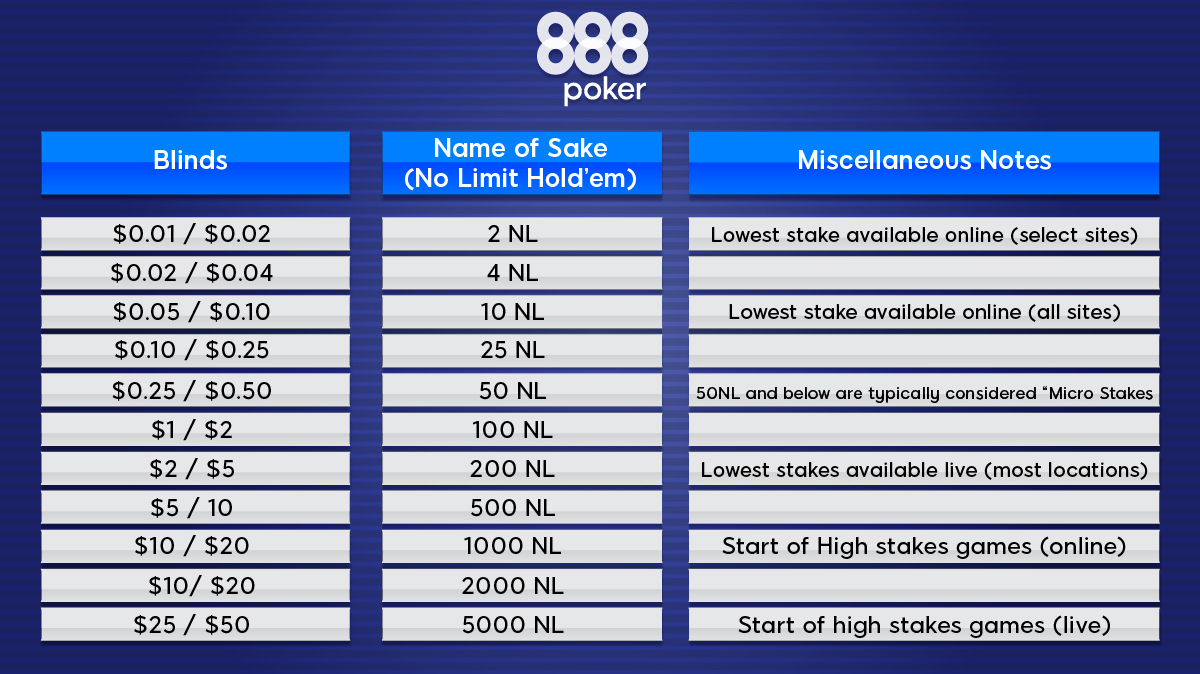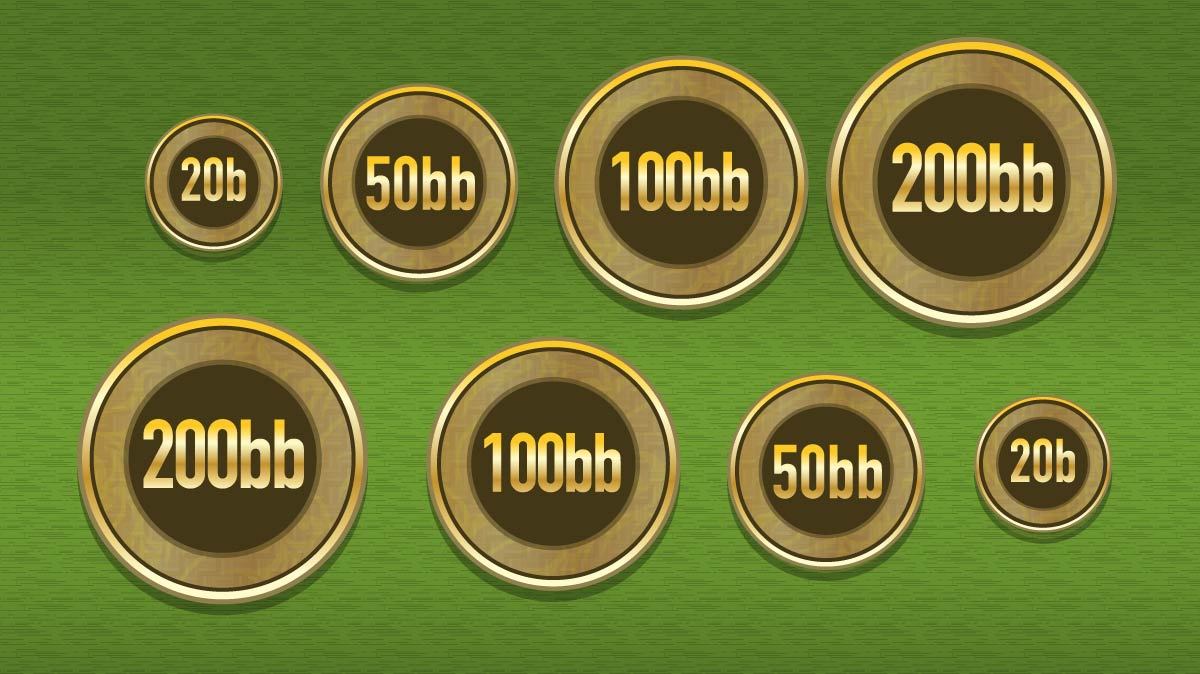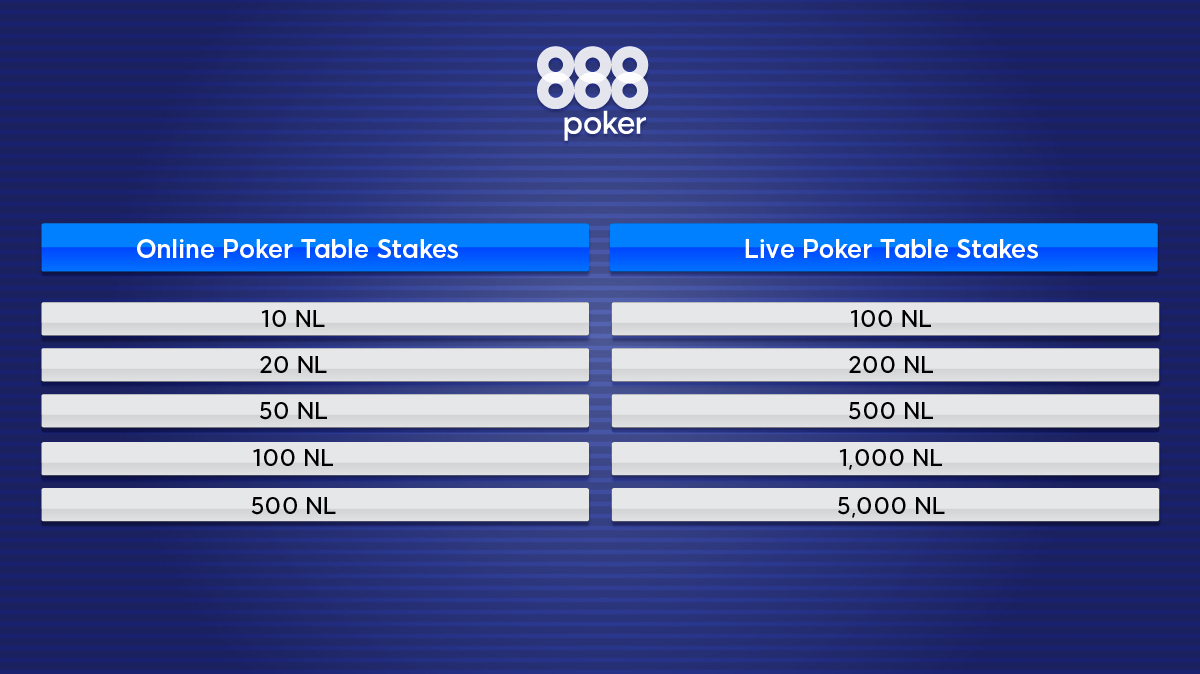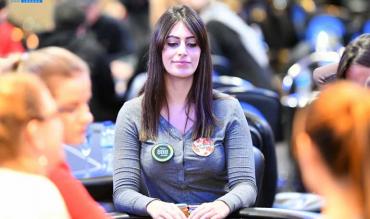In most forms of poker, such as the most popular one of No-Limit Texas Holdem, there are forced blind bets that must be put forward by the players to the immediate left of the button before any cards are dealt.
These blind bets are called the small blind and the big blind.
The most common stack size to find online in poker (and in “cap” / non-deepstack games for live play) are those that involve maximum buy-ins of 100 big blinds.
For example, in a $0.01/$0.02 micro stakes game online (note the coventional notation here for the writing of the $0.01 small blind and the $0.02 big blind), the maximum buy-in is very commonly going to be $2.00.
One way that players will abbreviate the name of this stake is by saying “2NL”. Here, the “2” is indicative of what a typical 100bb buy-in would be, and the “NL” represents no-limit for the game being played – No-Limit Texas Hold’em.
Table of Contents
- Poker Blinds Chart: Names of table stakes
- Understanding the Different Stakes
- Minimum and Maximum Buy-ins for Various Stakes
- Poker Terminology for Live Play: Going North/Going South
- Comparing Stakes and Win Rates: Live vs Online
- Always Remember the Importance of Game Selection
- Straddling: The “Bigger” Blind
- A Word on “Antes”
- In Conclusion
Poker Blinds Chart: Names of Table Stakes
Below, you can find a chart of the most common stakes found between online and live, along with some remarks about them:
NOTE: As aforementioned, the name of stake is representative of the $ amount for 100bb’s for that stake level.

Understanding the Different Stakes
The smallest game that can be found online is $0.01/$0.02 games, with a maximum buy-in of $2.00. Most commonly you can see this stake, at the very least, on the larger sites with higher traffic.
However, be aware that not all sites offer stakes this low; other sites may start at 4NL, 5NL (with blinds of $0.02/$0.05), or even 10NL.
Typically, the smallest game that can be found in live play is 200NL, with blinds of $1 and $2. In select locations, 100NL may be offered, though.
Minimum and Maximum Buy-ins for Various Stakes

All cardrooms and websites are going to have different minimum and maximum buy-ins for each stake. Maximums for online games are almost always going to be 100bb, while in live play it can increase to 300bb or more the higher up you go in stakes!
Minimums for online and live are generally the same, at either 20 to 25 big blinds; however, these minimums will often increase in live settings as you move up the stakes to accommodate for the increased maximum buy-ins you will find. Always be sure to know what the min and max buy-ins are for your table when you buy in.
Poker Terminology for Live Play: Going North/Going South
These poker terms are strictly for live play, as there is no technology as in online poker to prevent a player from going over the max limit or taking chips off the table. (These may be the rules of the cardrooms, but it can sometimes be difficult to enforce if no one notices it.)
“Going north” is a term used to reference when a player makes an initial buy-in or a rebuy that exceeds the maximum buy-in amount. Sometimes this will be only a few big blinds; other times, it might be up to a whole extra buy-in! Either way, it is disallowed.
It is the dealer’s responsibility to notice when players rebuy and/or buy-in and to ensure that it never exceeds the maximum. In the case that the dealer doesn’t see, it is okay if a player mentions to the dealer or the player in question about the maximum buy-in.
In some instances, the player in question isn’t aware of the maximum buy-in rules of the card room, as these can change from place to place.
NOTE: One time, I saw a player rebuy for an amount over the max buy-in of 100bb. They got involved in a big pot the very next hand and stacked another player, who had him covered. Even though the dealer didn’t notice the illegal top-up over the maximum before the hand, it was good to see that the dealer only permitted the all-in to be for the maximum of 100bb (the starting stack size for the beginning of the hand) once the amount of the all-in was tallied.
On the opposite end of the spectrum, “going south” refers to taking money off the table, which is not only against the rules of most cardrooms but is also highly unethical.
That said, in *some* instances, however, going south is permissible. This situation is true in some shortstack “all-in or fold” cash games online (i.e. with an 8bb buy-in), whereby a player is allowed to take the amount exceeded 8bb off the table). It’s also the case in some short deck NLHE games, where players are allowed to take off anything in excess of 300 antes for the stake of game being played.
Comparing Stakes and Win Rates: Live vs Online
While win rates online may be lower in terms of bb/100 than may be found in live play, this situation can be superseded by the fact that players will play more hands per hour online. They also have the ability to multi-table (play more than one poker table at the same time).
It’s also important to recognise the difference in starting stakes between online and live. In online play, you can jump into a 2NL game for pennies. Live, games usually start at 200NL.
Therefore, when accounting for the recreational players who are wanting to play, it makes sense that 200NL live games would be much softer (easier to beat) than 200NL online games.
As a general comparison, if you can beat a particular online stake of game, then you will likely be able to beat a live game with blinds of an amount 10x higher.
For example, if you can beat 50NL profitably online, then you can most likely probably beat 500NL in a live setting.

Always Remember the Importance of Game Selection
As players should go by their bankroll to determine the proper games they can play, playing at the highest stake possible (as per your BRM rules) isn’t always the best idea.
Sometimes 500NL live crushers even drop down to play 200NL for a session, simply because the 500NL tables were bad (reg-infested with few, if any, fish).
Straddling: The “Bigger” Blind
A straddle is where the player who is UTG in a hand in a cash game makes a blind raise that is equal to 2x the amount of the big blind. (In some instances, a straddle in a $1/$2 game may be to $5, though; this is cardroom dependent.)
This straddle is essentially like another big blind: the player to the left of the straddler will be first to act preflop, and the player who straddled will still have the option of checking/betting/raising/folding once the action gets to him as if he was a player in the blinds.
It should be noted that straddling is generally a losing play in the long-term, as you’re being forced to put more money into the pot while out of position (which already limits any edge you may have).
However, as it causes there to be more money in the pot before the flop is dealt (and it essentially halves the effective stack sizes), it commonly causes there to be much looser and more aggressive action, This factor is the potential benefit to doing it: causing otherwise tighter players to loosen up their game and give more action.
In most games, a straddle is voluntary – you don’t have to do it if you don’t want to. In other games, players agree to a mandatory straddle (even if it’s for just one round). Sometimes these mandatory straddles are seen in live, televised “big games”, where players might be playing $25/$50, and then the compulsory straddle makes it an even BIGGER game of $25/$50/$100!
Multiple straddles are often possible too (cardroom dependent) and can be done all the way up ‘til (and including) the player on the button.
Additionally, it should be noted that some cardrooms allow players to straddle from ANY position (even the button), even when a player before them hasn’t yet straddled. If this is the case, preflop action starts to the player to the left of the straddler (wherever that may be), and postflop action continues as usual.
Bottom line: be aware that straddles might be involved during gameplay, which will effectively double the stakes that you were planning to play. Therefore, you should alter your strategy somewhat for how you’ll approach the hand.
A Word on “Antes”
An ante (more commonly seen in poker tournaments than in cash games) is where either one player (i.e. typically the button or big blind) or all players must put forward a certain amount of chips into the pot before a hand begins, simply to add more “dead money” into the pot. Antes are not considered to be a part of the small or big blind bets and are separate from any preflop betting that may occur afterwards.
Usually, antes are only found in the highest stakes of cash games (if they are to be used even then). They do help create more action at the table, though (as there’s more money in the pot to be won pre-flop).
Additionally, it should be noted that antes also end up changing the typical effective post-flop SPR (stack-to-pot ratio) of all players, which call for a slight change of strategy than a regular, non-ante, 100bb buy-in game.
In Conclusion
Hopefully, this article has armed you with a good amount of information on how poker blinds operate at the various stakes in poker. Whether online or live, there is always a multitude of games to select from.
However, it’s essential to know the changes in poker strategy that may be necessary if there are antes or straddles involved, in addition to other factors, such as those regarding the minimum and maximum buy-in as they relate to the poker blinds.
Good luck at the felts!


